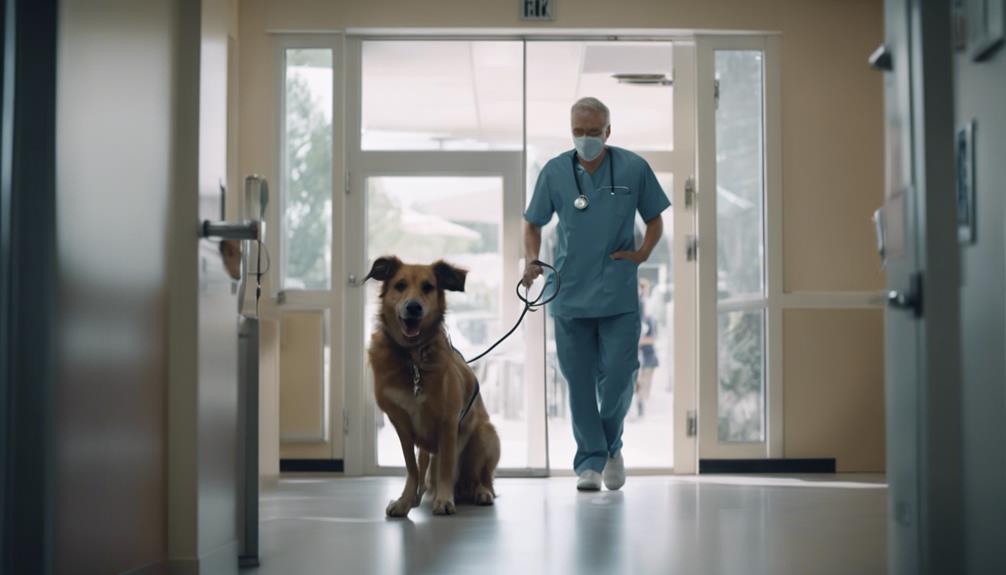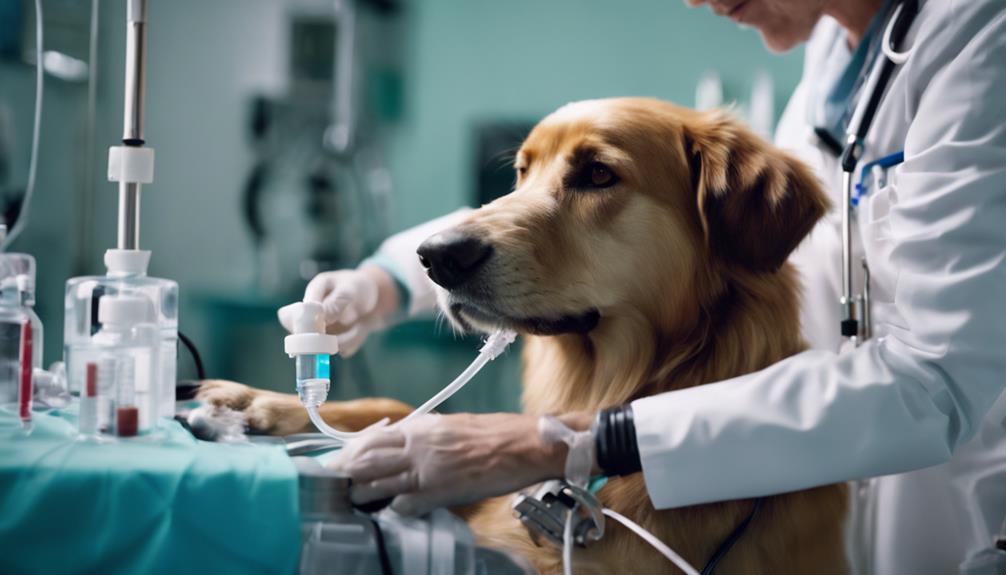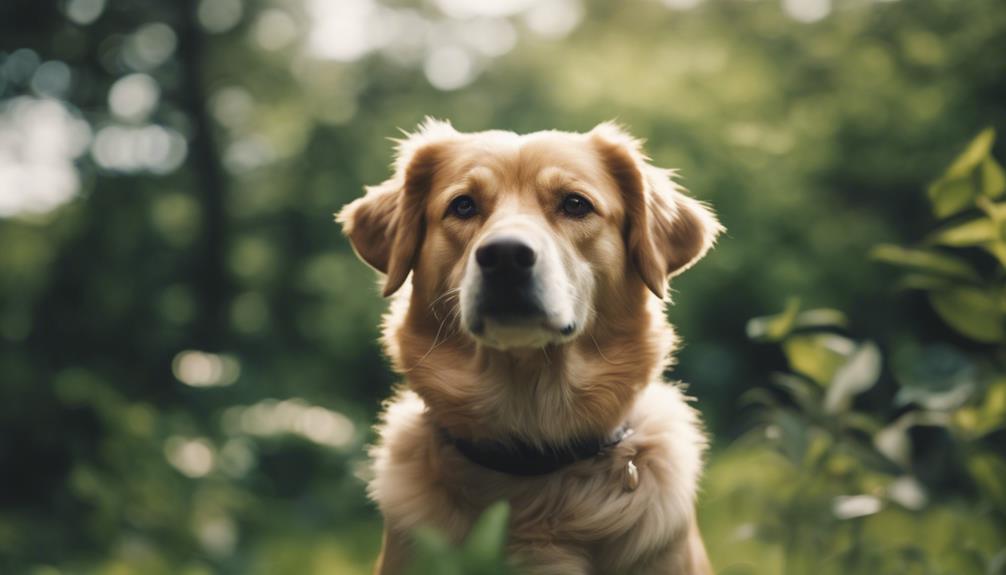Labored breathing in dogs is a critical indicator of potential health concerns that require immediate attention. From respiratory infections to heart conditions, various underlying issues can manifest through this symptom.
Understanding the root causes, effective treatment modalities, and preventive measures is paramount in ensuring the well-being of our canine companions.
By exploring the complexities of labored breathing in dogs, we shed light on the importance of vigilance and proactive care in safeguarding their health.
Key Takeaways
- Labored breathing in dogs requires immediate veterinary attention and after-hours emergencies need a visit to a veterinary emergency facility.
- Diagnosis involves blood work, chest X-rays, and additional tests like an echocardiogram to determine the underlying cause.
- Treatment often involves hospitalization, oxygen therapy, monitoring, procedures like tapping, and medications like steroids and antibiotics.
- Prognosis varies based on the cause, with early and appropriate treatment leading to a better outlook in some cases.
Signs and Symptoms of Labored Breathing
Labored breathing in dogs manifests as difficulty in inhaling, exhaling, or both, often accompanied by tachypnea and excessive panting. It is crucial to observe for signs such as open-mouth breathing, extended neck and head, noisy breathing, and blue gums or tongue, indicating a lack of oxygen. Dogs may also exhibit restlessness, weakness, coughing, or wheezing when experiencing labored breathing.
Owners should pay attention to any changes in their pet's respiratory rate or effort, as these can be early indicators of a problem. Prompt recognition of these symptoms is essential for seeking immediate veterinary care, as labored breathing can be a sign of serious underlying health issues that require swift intervention to ensure the well-being of the dog.
Common Causes and Triggers
A thorough examination of potential factors contributing to labored breathing in dogs reveals a range of common causes and triggers that warrant careful consideration by veterinary professionals. Some prevalent causes include respiratory infections such as pneumonia or kennel cough, which can lead to inflammation and narrowing of airways. Heart conditions like congestive heart failure may also result in labored breathing due to fluid buildup in the lungs.
Additionally, obstructions in the airway, such as tumors or foreign objects, can impede normal breathing. Allergies, asthma, or chronic conditions like bronchitis are other common triggers of labored breathing in dogs. Identifying these underlying causes is crucial for effective treatment and management to ensure the well-being of the affected canine.
Immediate Veterinary Care and Evaluation

Upon observing signs of respiratory distress in dogs, prompt veterinary care and evaluation are imperative to swiftly address potential underlying causes and ensure the well-being of the animal.
Respiratory distress can be life-threatening, and immediate action is crucial. Owners should contact their veterinarian or seek emergency care if their dog shows symptoms such as difficulty breathing, wheezing, or excessive panting. In cases of after-hours emergencies, visiting a veterinary emergency facility is advised.
Veterinarians will perform a thorough physical examination, which may include assessing vital signs, oxygen levels, and listening to the lungs and heart. This initial evaluation is vital in determining the severity of the condition and establishing a treatment plan tailored to the dog's specific needs.
Diagnostic Process and Testing Methods
When addressing labored breathing in dogs, the diagnostic process and testing methods play a crucial role in identifying the underlying causes and determining appropriate treatment strategies. Diagnosis often involves blood work, measuring blood oxygen levels, and chest X-rays to provide valuable insights. Additional tests such as an echocardiogram and electrocardiogram may be recommended to further evaluate the condition. Sedated examination of the larynx can offer additional information, and more advanced imaging like a CT scan might be necessary based on initial findings. These diagnostic tools help veterinarians pinpoint the root cause of the labored breathing, guiding them towards an effective treatment plan.
| Diagnostic Methods | Description | Purpose |
|---|---|---|
| Blood Work | Analyzes blood for abnormalities | Identifying potential underlying issues |
| Chest X-rays | Images of the chest area | Evaluating lung and heart conditions |
| Echocardiogram | Ultrasound of the heart | Assessing cardiac function |
Hospitalization and Treatment Approaches

Hospitalization and treatment strategies for labored breathing in dogs are essential components of comprehensive veterinary care when addressing this critical condition. Once a dog is admitted, continuous monitoring by trained staff is crucial, ensuring prompt intervention if necessary.
Oxygen therapy, administered through an oxygen kennel or nasal tube, helps alleviate respiratory distress. Additional treatments, such as tapping to remove fluid or air, may be performed as needed. Medications like steroids, antibiotics, and diuretics are commonly prescribed to address underlying causes.
The 24-hour care provided during hospitalization allows for close observation and immediate adjustments to the treatment plan, optimizing the dog's chances of recovery. This intensive approach is aimed at stabilizing the dog's condition and improving their overall prognosis.
Factors Influencing Prognosis
Factors influencing the prognosis of labored breathing in dogs encompass the underlying cause, promptness of intervention, and response to treatment. The prognosis can vary greatly depending on these factors. Here is a table summarizing key elements affecting the prognosis of labored breathing in dogs:
| Factor | Influence | Example |
|---|---|---|
| Underlying Cause | Identifying and addressing the root issue is crucial for prognosis | Heart failure |
| Prompt Intervention | Early recognition and immediate treatment can improve outcomes | Administering oxygen quickly |
| Response to Treatment | A positive response to therapy is indicative of a better prognosis | Decrease in respiratory rate |
Understanding and managing these factors are essential in determining the prognosis and overall outcome for dogs experiencing labored breathing.
Strategies for Preventing Labored Breathing

Understanding the critical role of proactive veterinary care and timely interventions is paramount in safeguarding dogs against the onset of labored breathing.
To prevent labored breathing in dogs, consider the following strategies:
- Regular Veterinary Check-ups: Schedule routine wellness exams to detect any potential issues early on.
- Vaccination Protocols: Adhere to recommended vaccination schedules to prevent infectious diseases that could lead to labored breathing.
- Prompt Medical Attention: Seek immediate veterinary care if your dog shows any signs of respiratory distress or abnormal breathing patterns.
- Healthy Lifestyle: Maintain a balanced diet, provide regular exercise, and ensure a safe environment to promote overall well-being and respiratory health in dogs.
Conclusion
In conclusion, recognizing signs of labored breathing in dogs is crucial for prompt intervention and treatment. Immediate veterinary care and thorough evaluation are essential for diagnosing underlying health issues. With proper diagnosis and treatment, the prognosis of labored breathing in dogs can vary.
Preventative measures, such as regular wellness exams and vaccinations, play a significant role in safeguarding canine health and reducing the risk of respiratory distress.




